After a coffee break, I headed towards a famous local farmer’s market – Mercado dos Lavradores. This is the place where flower, fruit and vegetable growers, as well as the fishermen bring their produce for sale. To start with, at the very entrance you are greeted by a nice image made of azulejo tiles (or just azulejos), which Portugal is famous for.
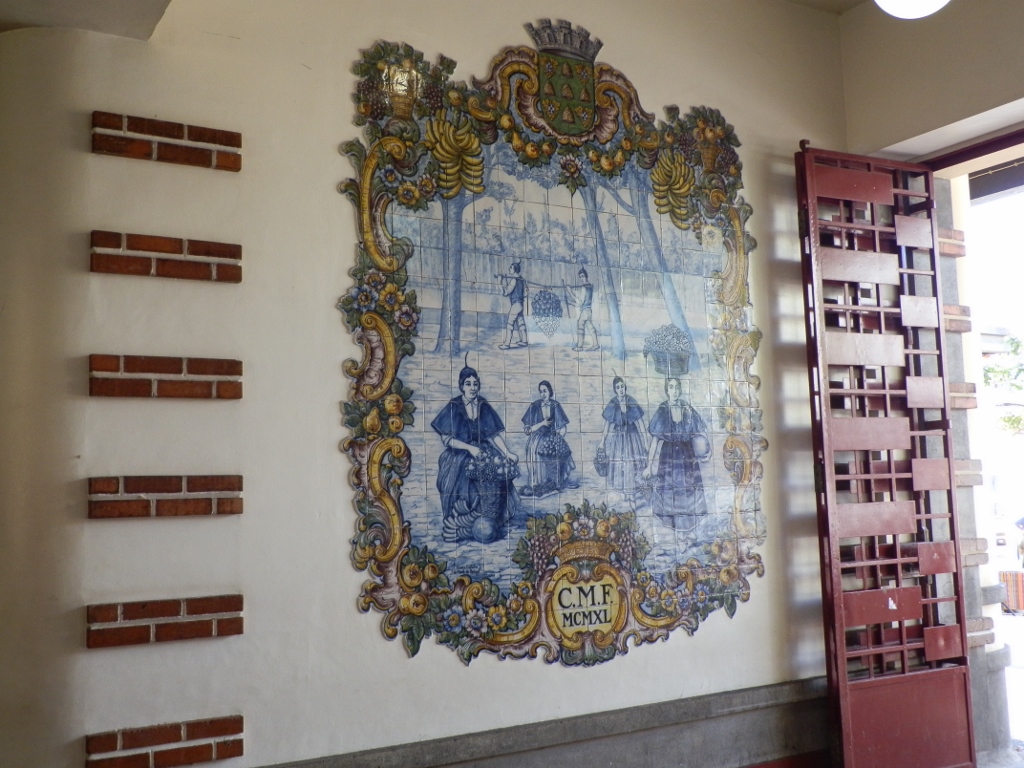 Entrance into the market
Entrance into the market
And then one enters a magical world of flowers, fruits and vegetables.
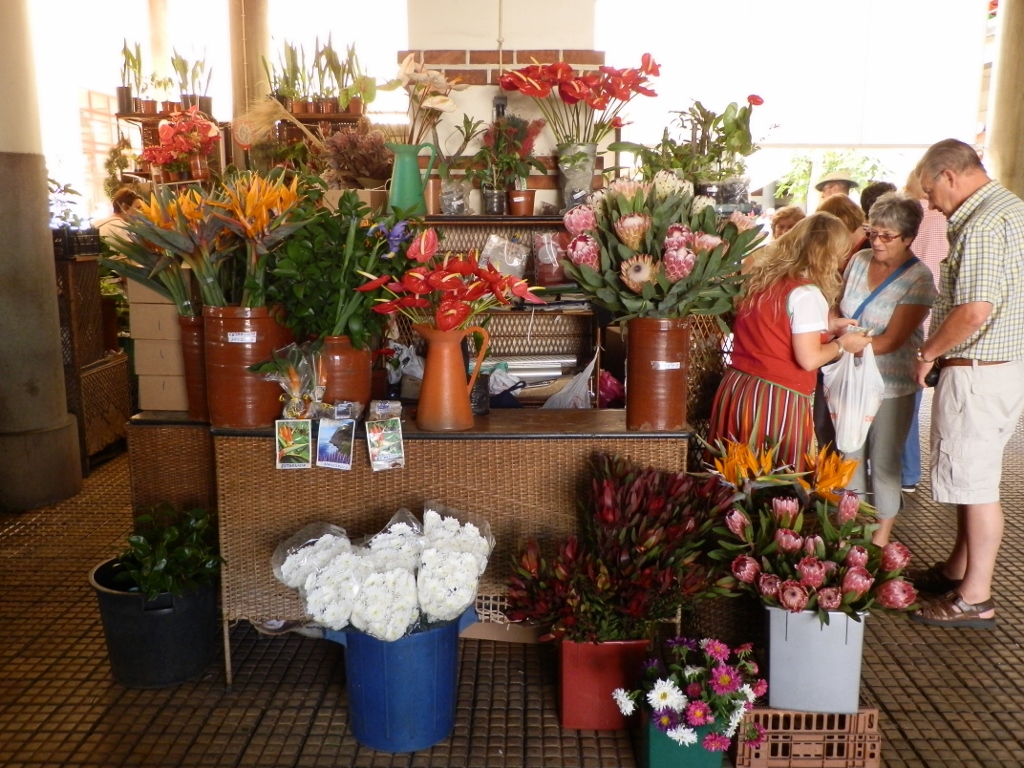 You are welcomed by a flower stand
You are welcomed by a flower stand
The market in Funchal has a couple of floors that surround a central courtyard and, like in any other good market, it is very lively here.
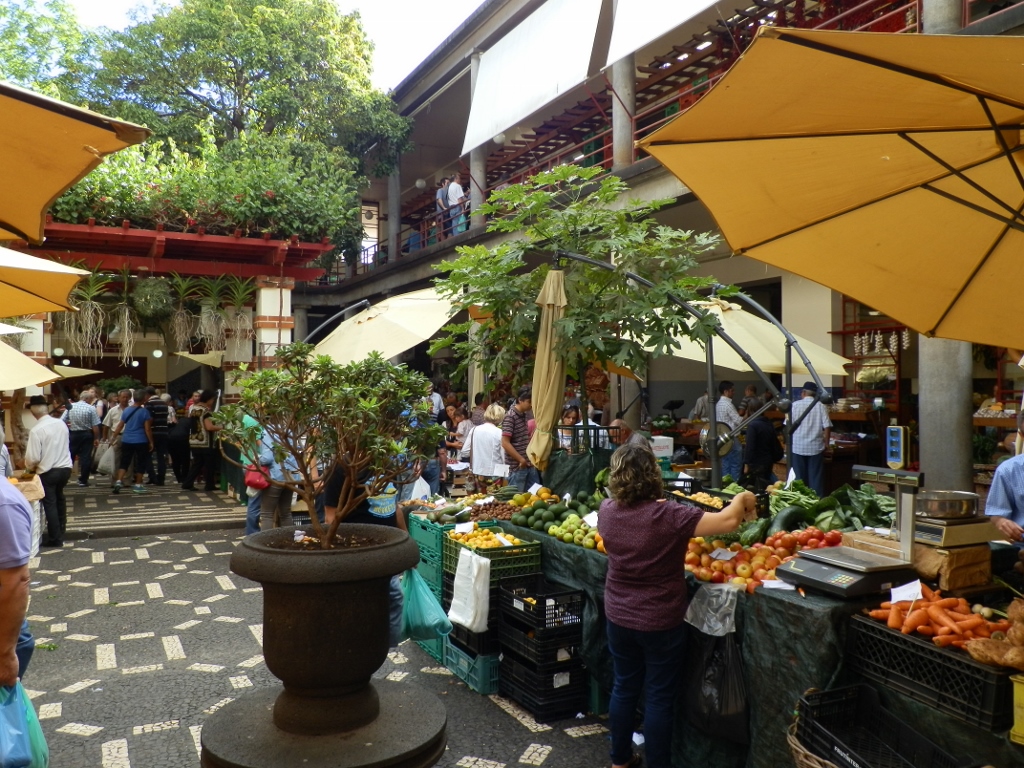 Central courtyard at the market in Funchal
Central courtyard at the market in Funchal
Although I love eating vegetables, somehow I always find it more interesting to take photos of fruits, especially when they are “exotic.”
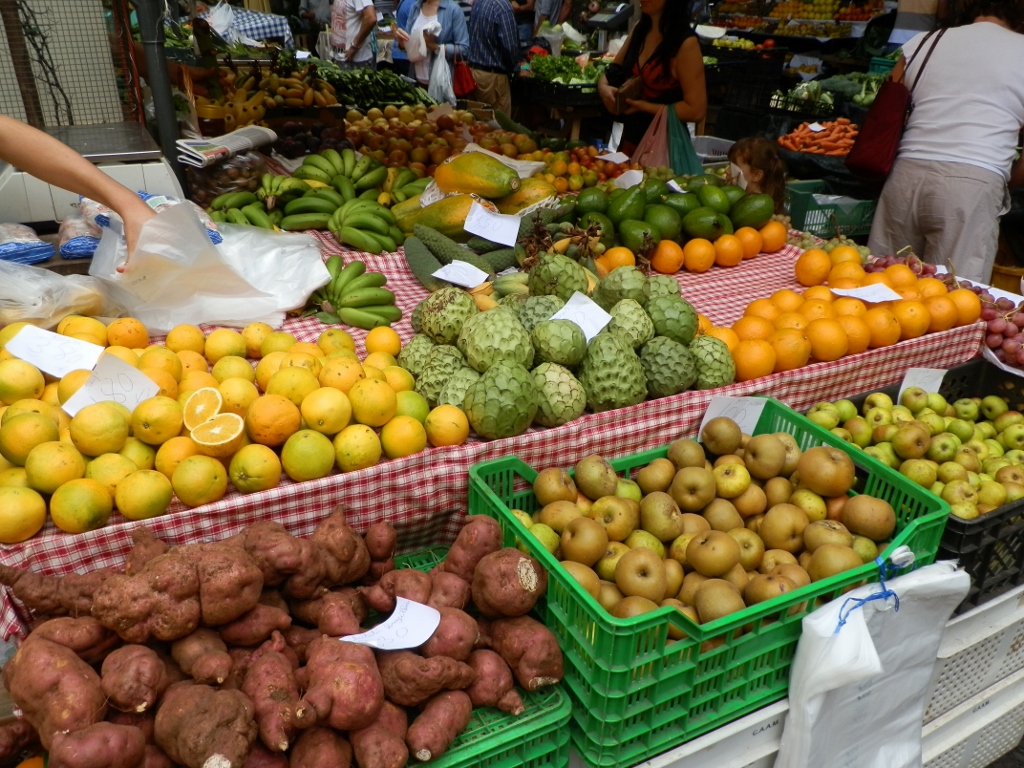 Mostly usual fruits and a little vegetables, and then...
Mostly usual fruits and a little vegetables, and then...
Here I came across the fruit of a plant called delicious monster which comes from its Latin name Monstera deliciosa. Its Latin name is interesting because it constitutes a combination of words monstera, meaning monstrous, on account of its potential size since it can often be higher than 9 metres (this is a creeping plant and it can grow like this when it comes to a suitable tree that it wraps itself around). The second part of the name, deliciosa, comes from the fact that its fruit is very tasty. It has the shape of a banana and the taste of a pineapple. It may also be grown as a house plant and so we come to yet another interesting name this plant has – Swiss cheese plant. The reason for such name lies in the fact that its leaves are full of holes and very often it is mixed with lacy tree philodendron (Philodendron selloum) which is all but edible.
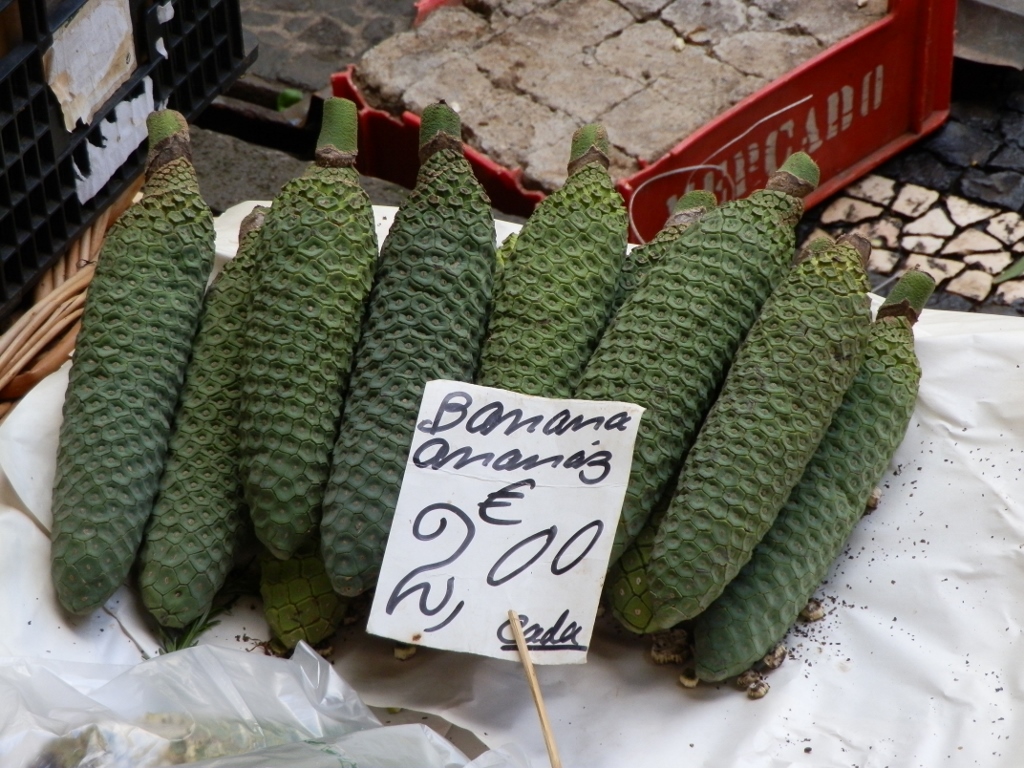 Delicious monster
Delicious monster
In the market there was also tamarillo on offer. This is fruit which in its different names in different languages often has the word tomato and yet this is fruit and it is used as such.
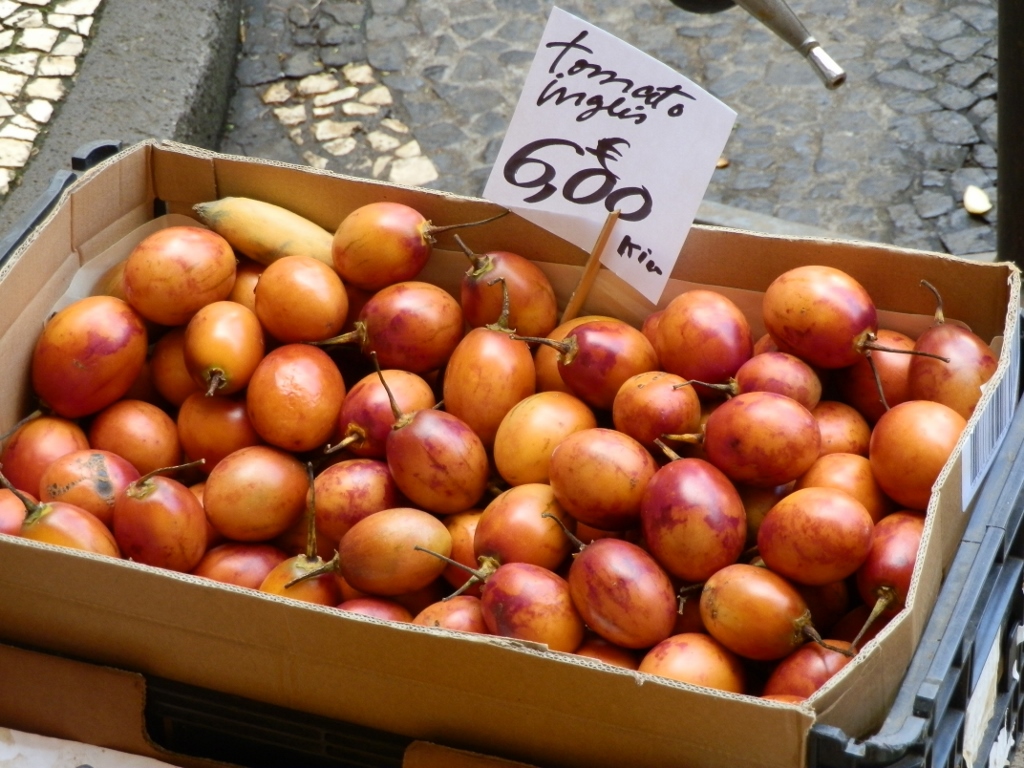 Tamarillo (literal translation from Portuguese: English tomato)
Tamarillo (literal translation from Portuguese: English tomato)
The market also has a section for the sale of fish and seafood.
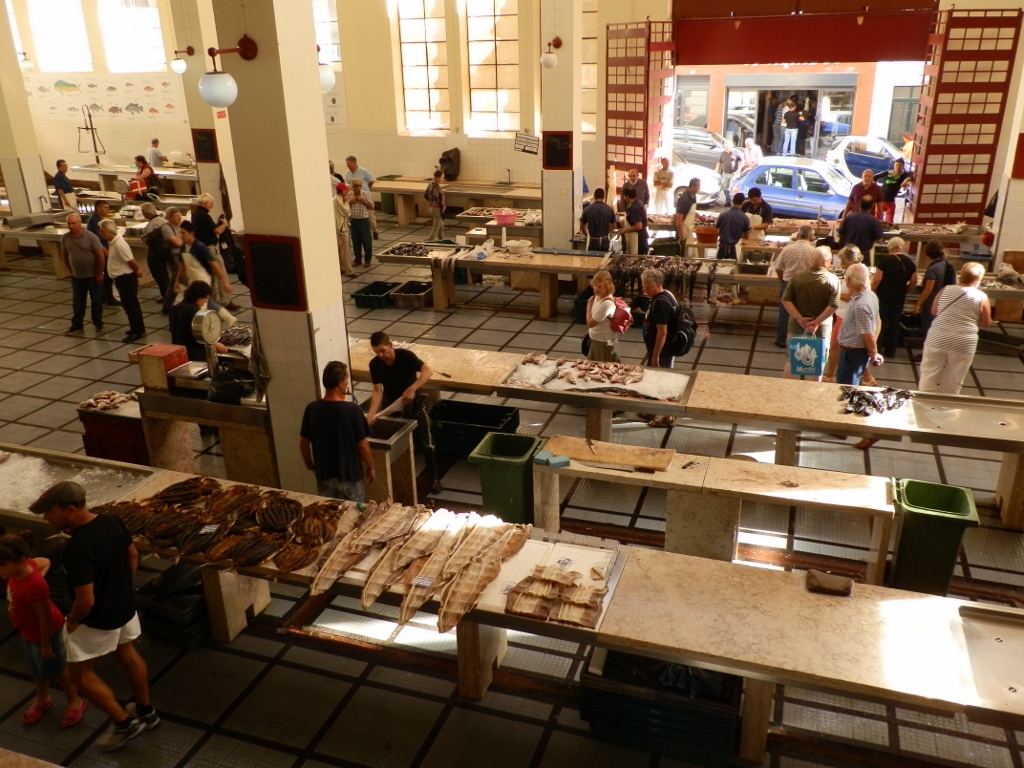 Funchal market: fish and seafood section
Funchal market: fish and seafood section
I looked around here as well and for me the most interesting was certainly the black scabbardfish (Aphanopus carbo).
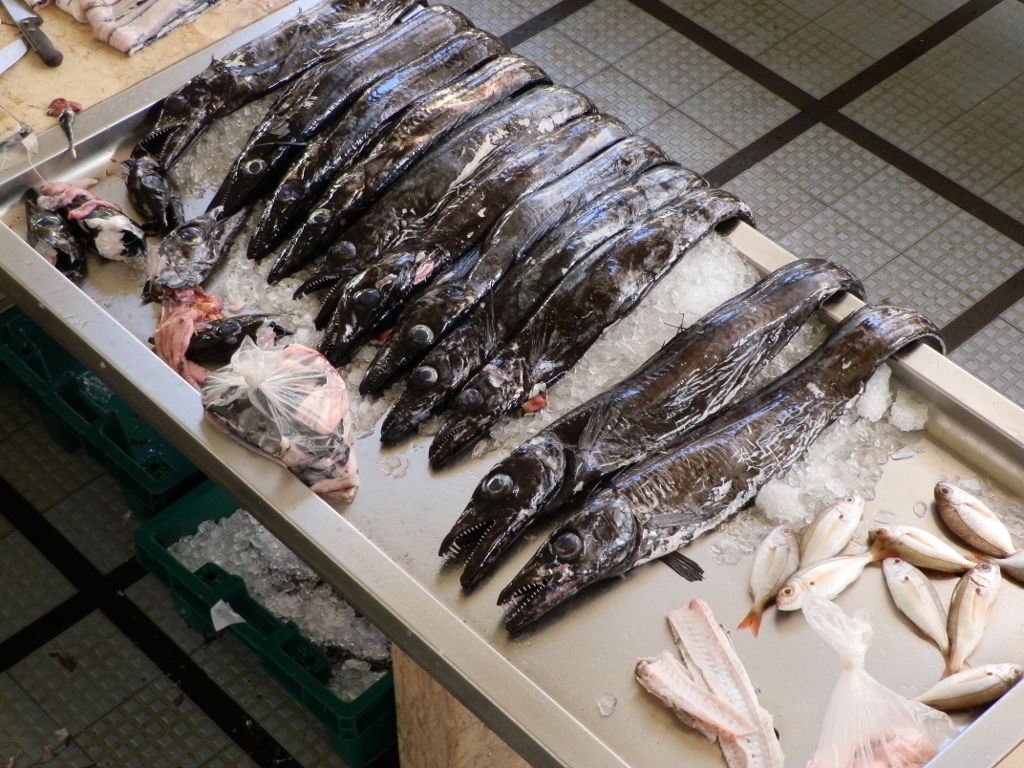 Stall offering the black scabbardfish among other things
Stall offering the black scabbardfish among other things
Still, I think that fruits are significantly nicer for visual appreciation and at different stalls in the market there is also a possibility to try different fruits, such as different types of maracuja, i.e., passion fruit. At one stall I counted as many as seven different varieties of passion fruit!
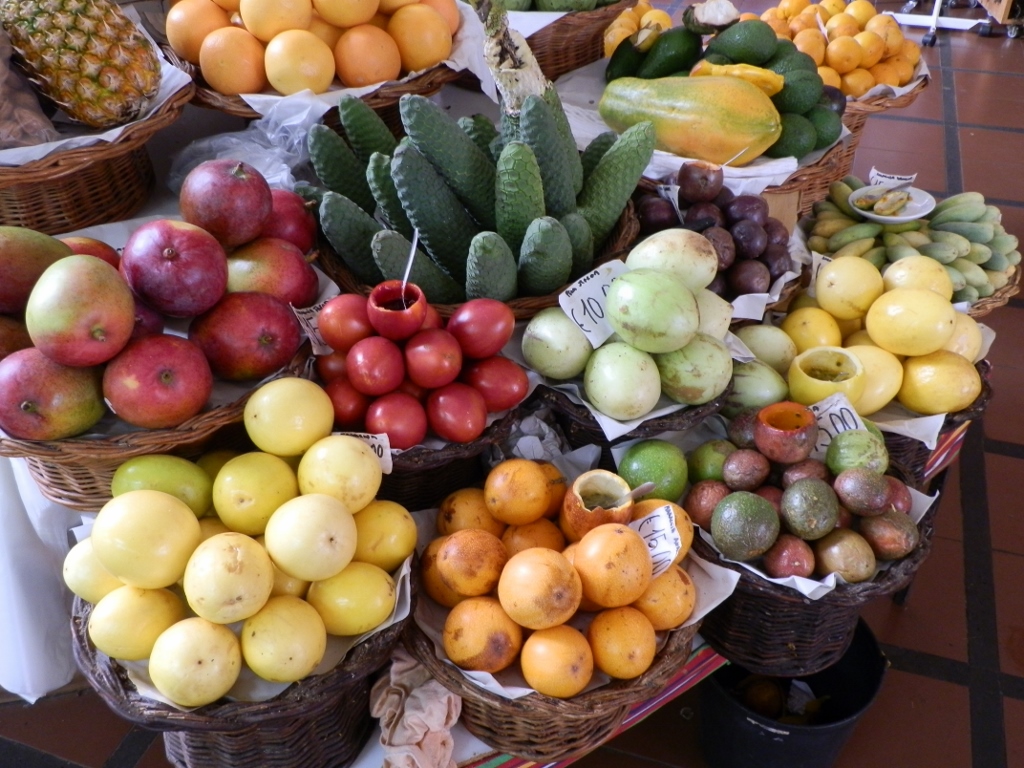 Stall where one can try different varieties of passion fruit
Stall where one can try different varieties of passion fruit
Then I went to the upper floor continuing to enjoy different sights, with an addition of dried fruits, as well as hot chilli peppers. Here it is...
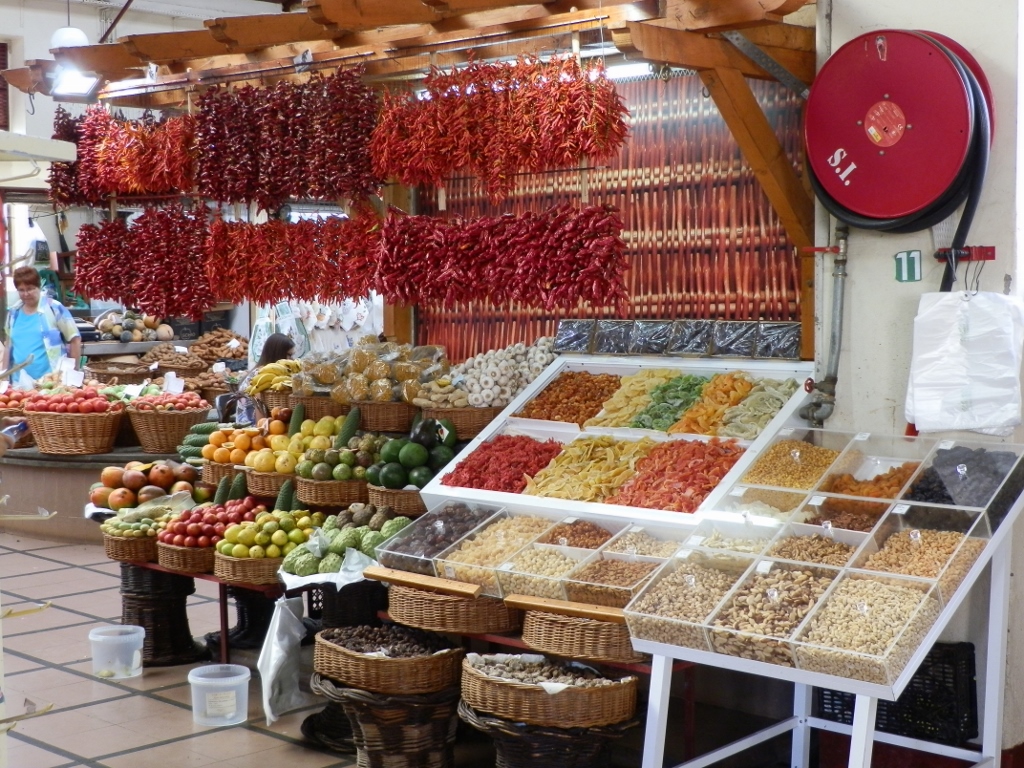 Sights from the Funchal market
Sights from the Funchal market
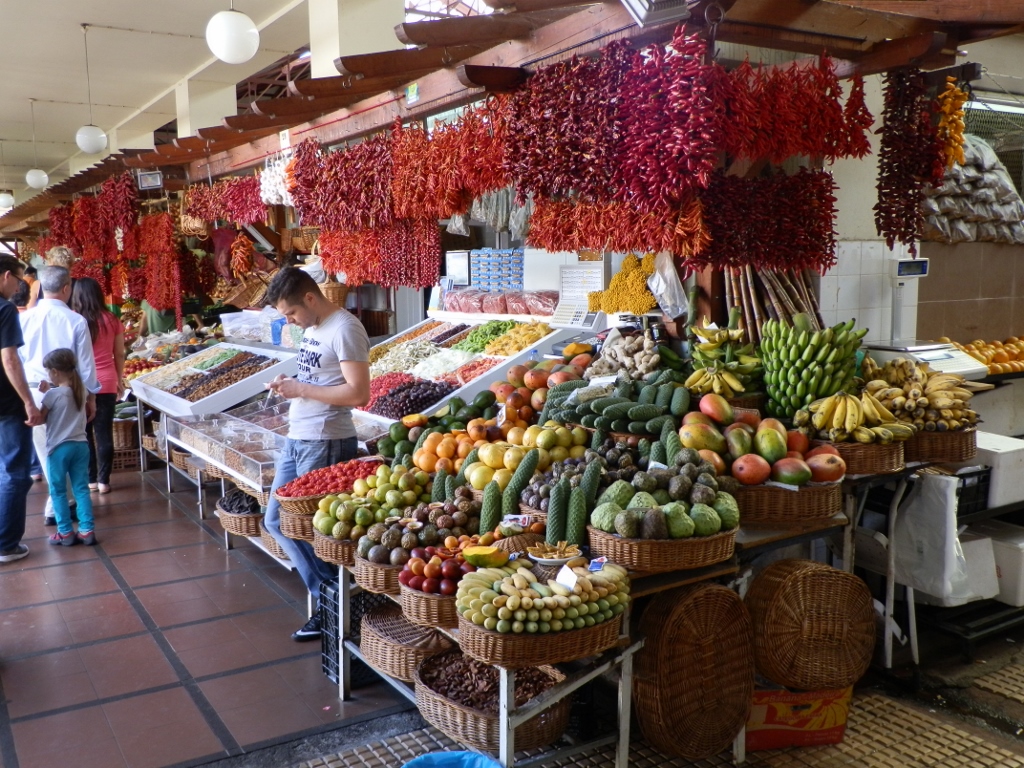 Sights from the Funchal market
Sights from the Funchal market
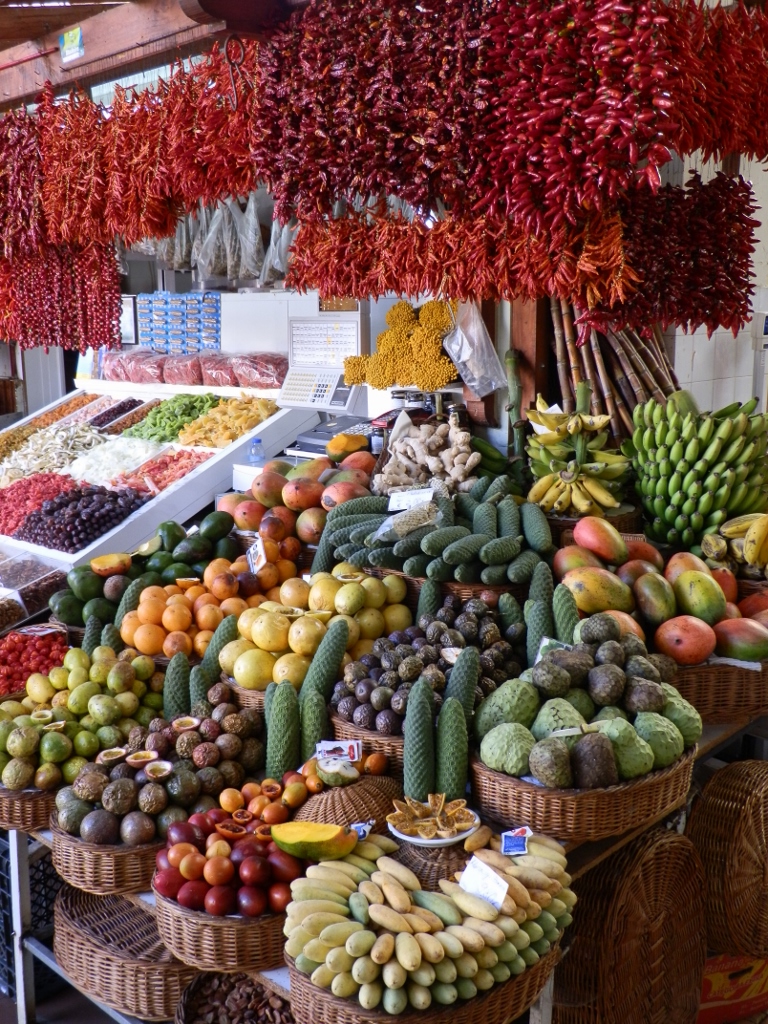 Sights from the Funchal market
Sights from the Funchal market
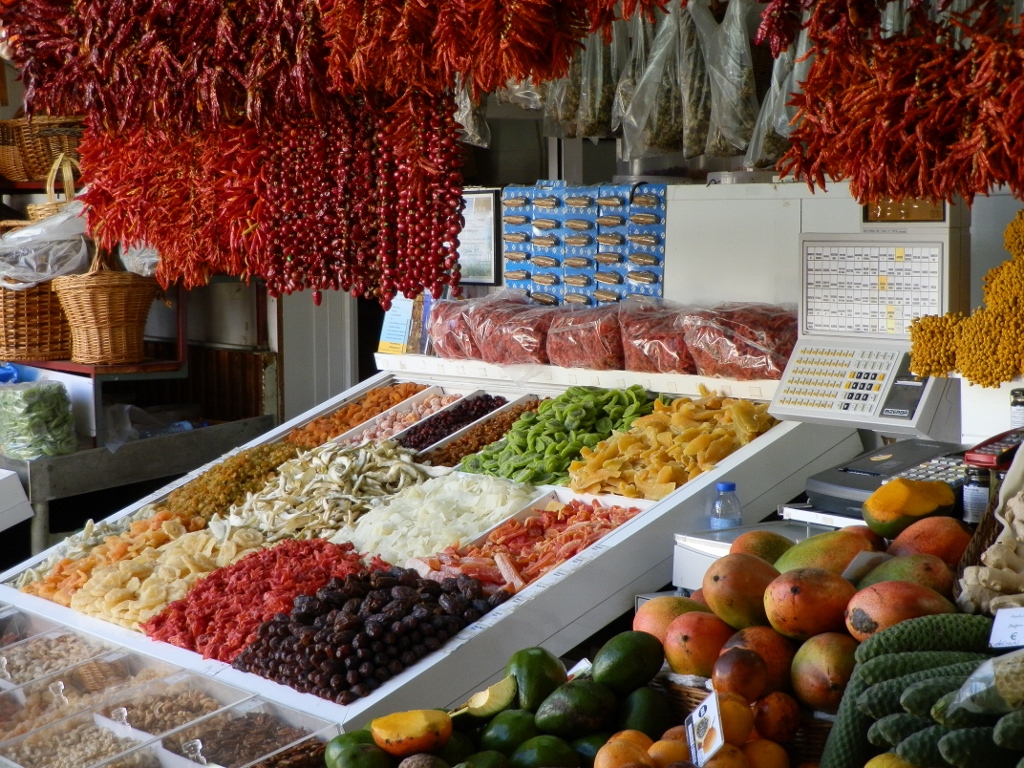 Sights from the Funchal market
Sights from the Funchal market
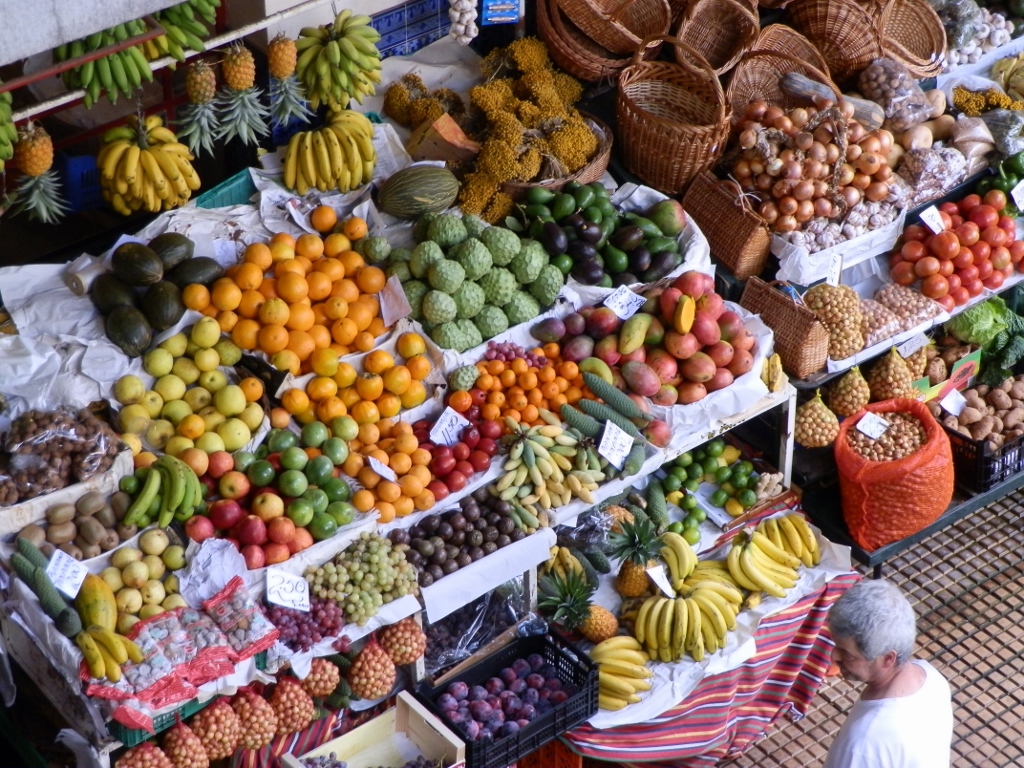 Sights from the Funchal market
Sights from the Funchal market
After the nice visit to the market, I went out to the streets of Funchal once again and headed for the parts of the city that extend parallel to the shoreline, but walking along side streets, as there was less traffic and I found them more interesting. Thus I came across the City’s Gate or rather the reconstruction of the main city’s gate from the times when the city was surrounded by walls. As the city expanded, these walls were removed and the original gate was destroyed in 1911. However, in 2004 there was an initiative to reconstruct the gate and after historical research a new gate was made and placed at the old site. Admittedly, the new gate is made of concrete, but it is covered in ashlar, while on its top there are remains of the originals –the crown, the royal arms and the inscribed stone.
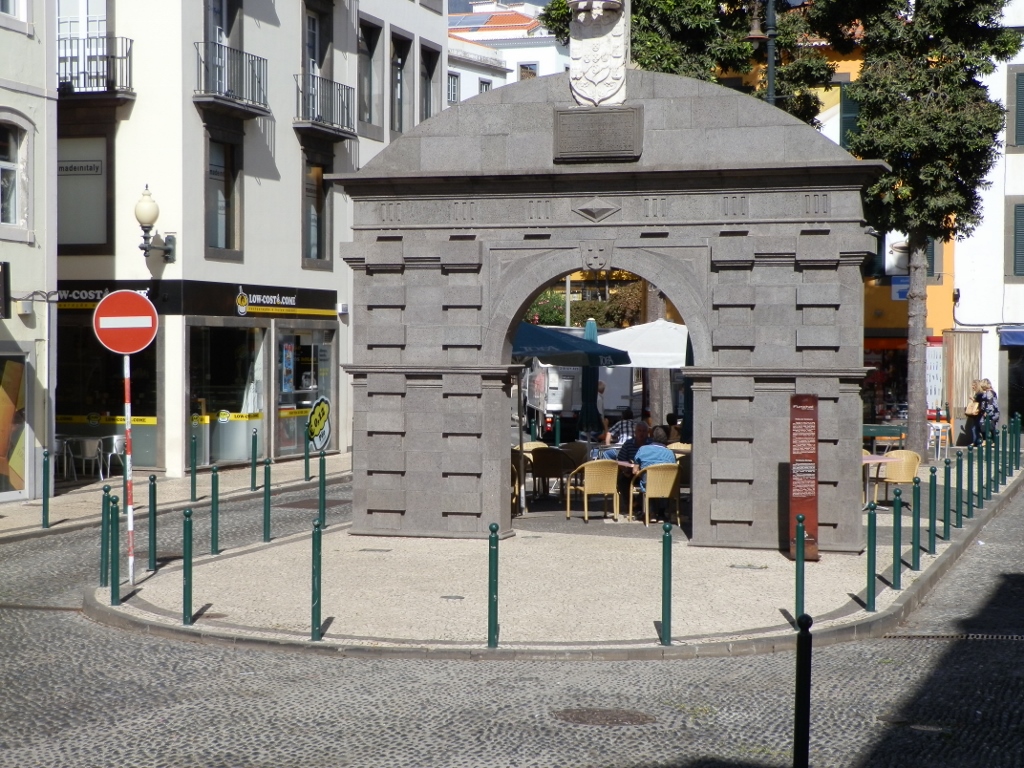 Replica of the City’s Gate
Replica of the City’s Gate
Some hundred metres away, I came across a narrow, but comparatively long square that is like a plateau elevated in relation to the pavement along the avenue which runs beside the ocean and which is aptly called Avenida do Mar (Sea Avenue). There is a small Chapel of Santo António da Mouraria (Capela de Santo Antonio de Mouraria) from 1715 here.
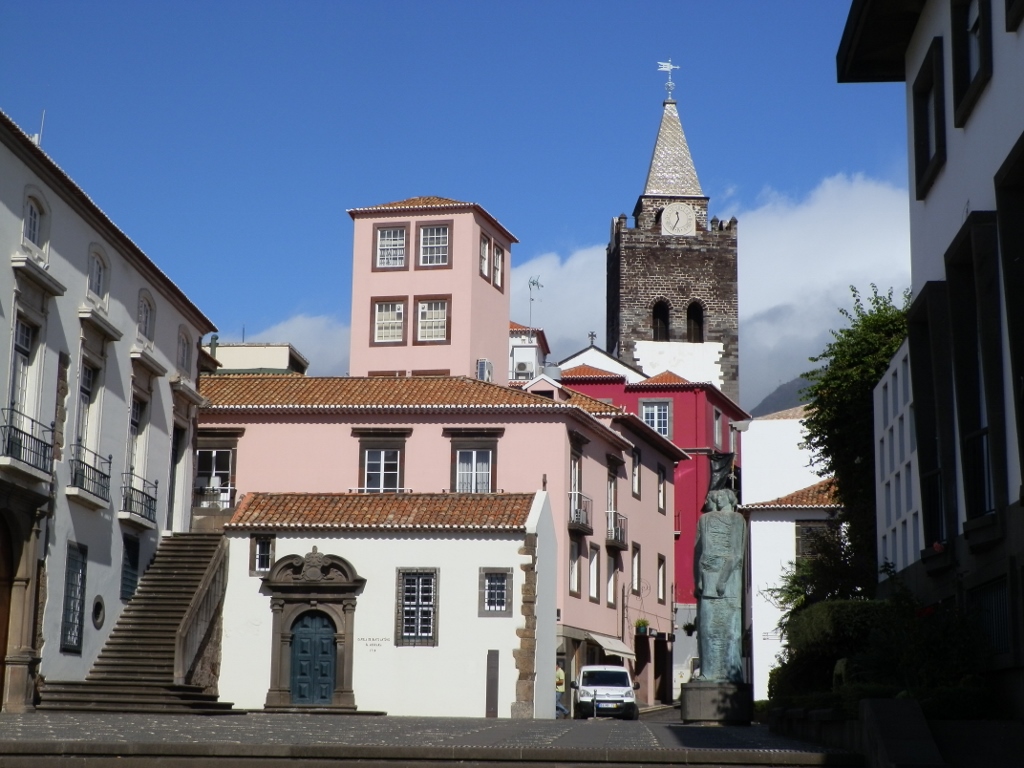 Chapel of Santo António da Mouraria, with the Cathedral’s bell tower in the background
Chapel of Santo António da Mouraria, with the Cathedral’s bell tower in the background
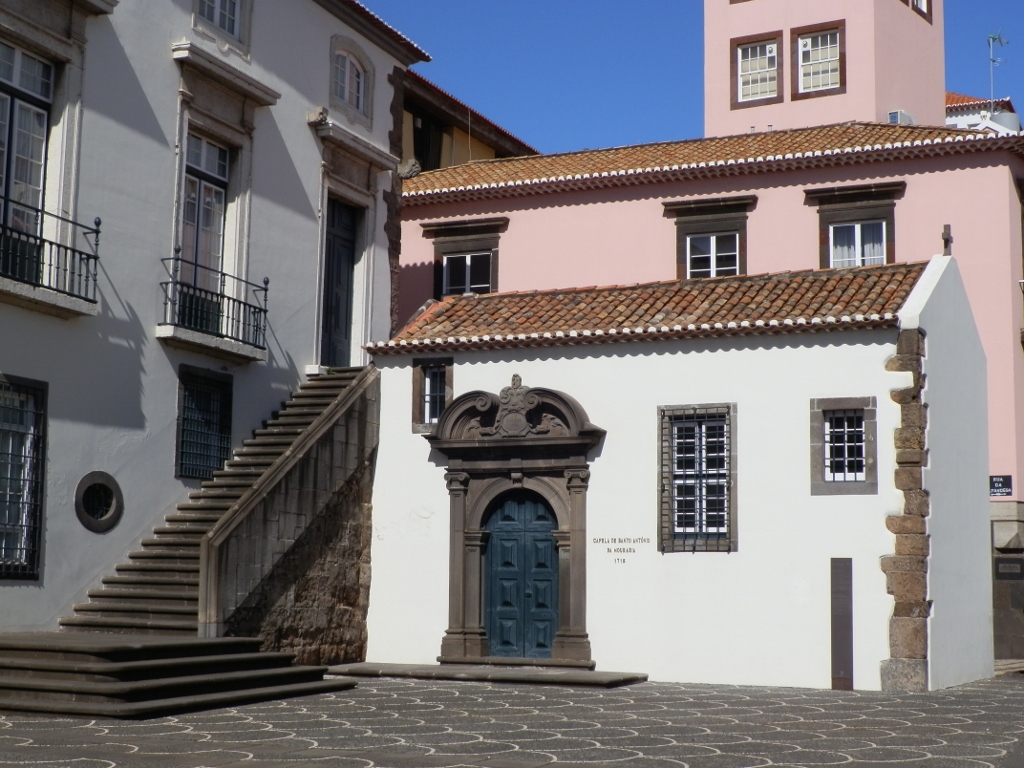 Chapel of Santo António da Mouraria
Chapel of Santo António da Mouraria
While I was in this square, I noticed decorative plantings of the bird of paradise flowers that grow out in the open here.
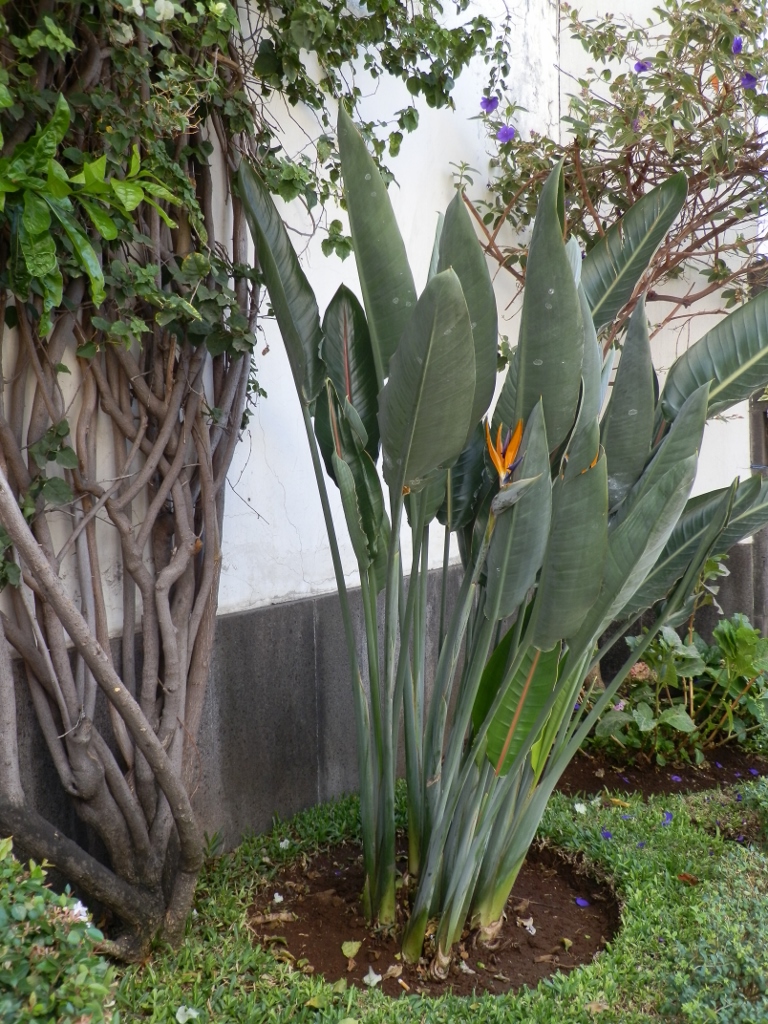 Bird of paradise plant
Bird of paradise plant
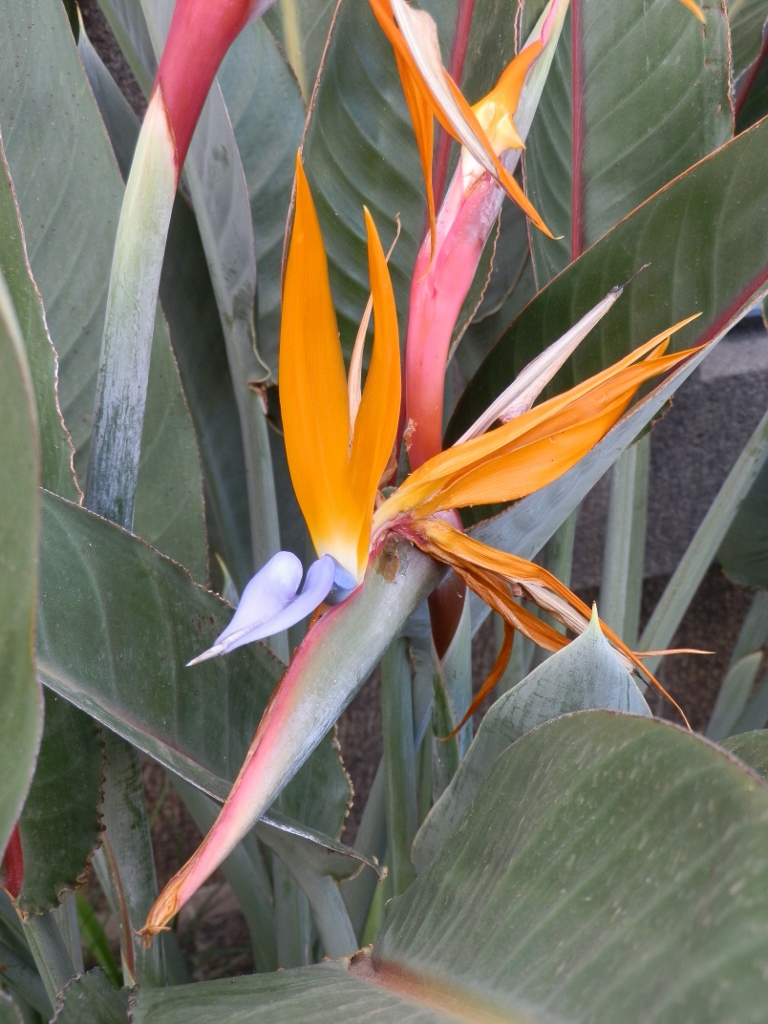 Bird of paradise flower
Bird of paradise flower
Having continued with my walk along the wide pavement beside Avenida do Mar I came to Saint Lawrence Palace (Palácio de São Lourenço). As I’ve already said in the previous part of the story about my visit to Madeira, this is a combination of a palace and a fortress the construction of which started in the 16th century. Parallel to the back section of the palace there is the broad pavement that I had already passed, but now I had the pleasure of seeing the front part of the palace lit by the Sun.
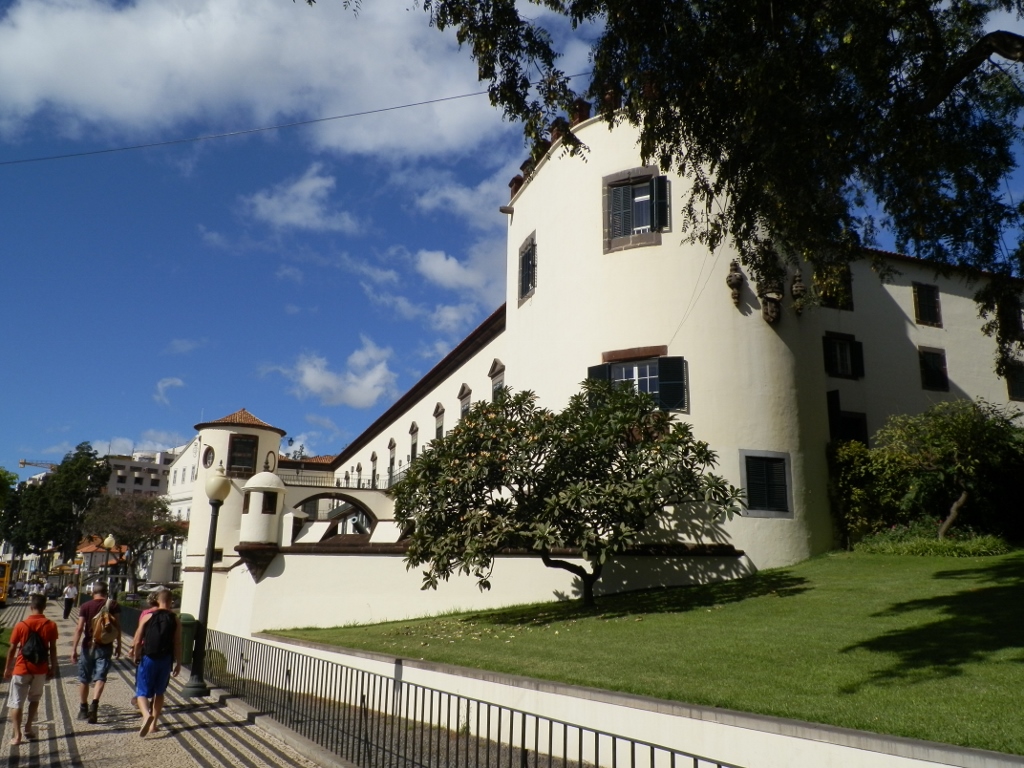 Saint Lawrence Palace
Saint Lawrence Palace
So, the first fortress in this place was built in the 16th century, but it was not sufficient for providing a proper defence and therefore the structure kept having additions and extensions up until the 19th century.
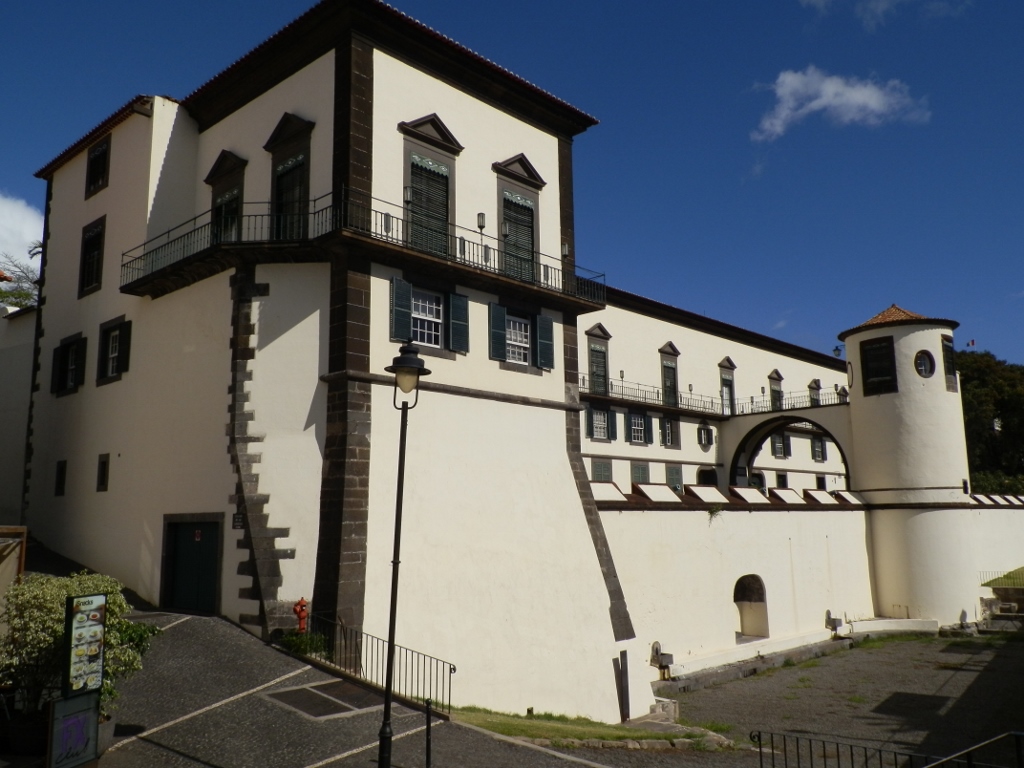 Saint Lawrence Palace
Saint Lawrence Palace
Then, going through a narrow lane that runs beside the palace, I returned to the promenade that extends between the back section of the palace and Avenida Arriaga. Each time I remember this part of Funchal, I have the notion of a pedestrian zone in my head, while in fact there is a street used by vehicles. Still, there is quite a clear reason why my brain makes this “error” – the pedestrian zone is significantly wider than the street and therefore it dominates the space. Still, in the following photo, between the trees, it is possible to discern a red tourist double-decker bus passing by the avenue.
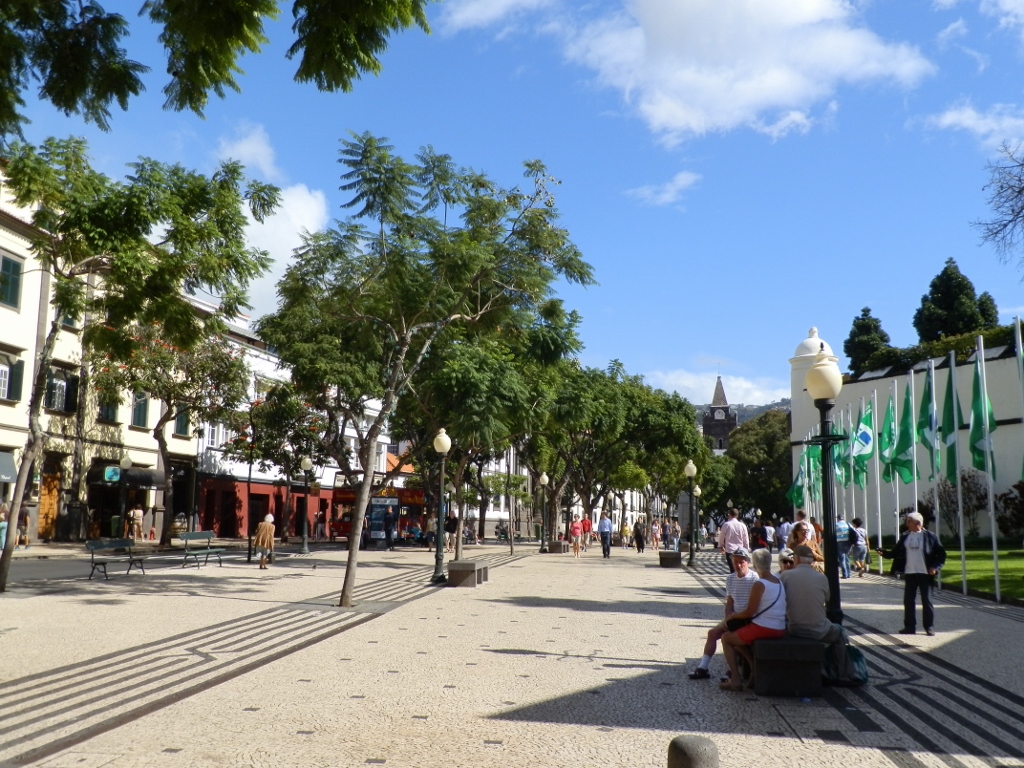 Promenade along Avenida Arriaga
Promenade along Avenida Arriaga
Not far from the place from which I took the photo of the promenade, there is a restaurant with the same name as several famous world hotels, but this venue here offers only food. As far as its exterior is concerned, I was attracted by the azulejo tile decoration used for adorning buildings both from the outside and from the inside.
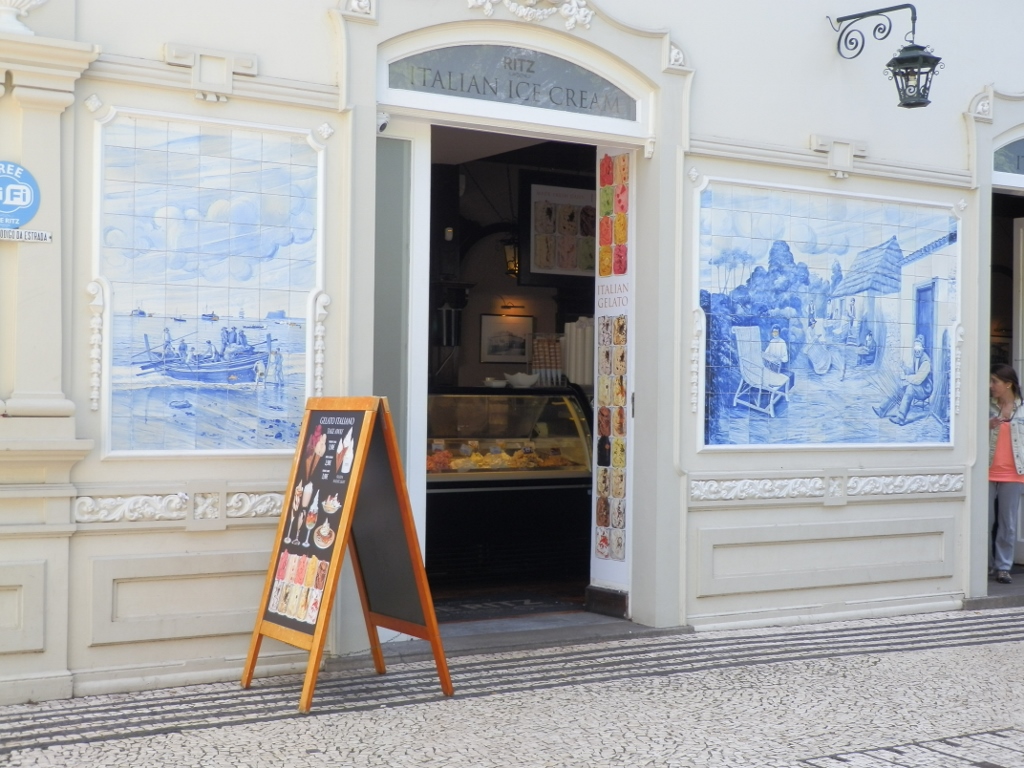 Exterior decoration using the azulejo tiles
Exterior decoration using the azulejo tiles
As you can see in the inscription in the photo above, the restaurant has its confectionary section which offers Italian ice-cream. But, why eat Italian ice-cream in Portugal when there is local pastel de nata?
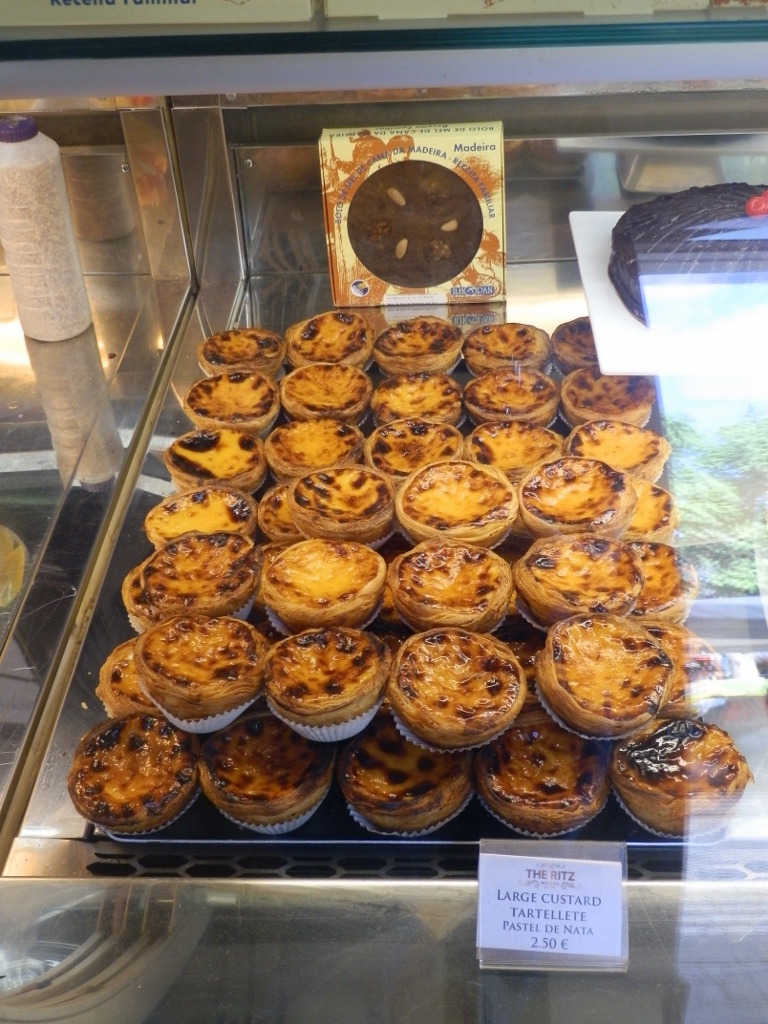 Pastel de nata
Pastel de nata
Then I got out to the walking area by the shore and thus I got to the Autonomy Square (Praça da Autonomia). The area around the square is the place where two small rivers join before entering the Atlantic Ocean. At the time when I got to this place, there was a high tide and not much water in the riverbed, so from time to time I could get an impression that it was the Atlantic Ocean flowing into the river. What is much more important than this trivial detail is that the beds of these rivers are very deep and fenced off by concrete walls. The reason for this is that on this island, which is one of the paragons of eternal spring and almost ideal climate, there are occasionally very heavy rains over a short period of time. Madeira is actually not a very big island and there are a lot of mountains on it with the highest peak, Pico Ruivo, being 1861 m a.s.l. This means that these large quantities of rainfall turn into flash floods and, like anywhere in the world, on Madeira, too, they can create a proper havoc. For this reason, the Portuguese have decided to deal with this risk and hence this seemingly extreme development of the riverbeds and banks.
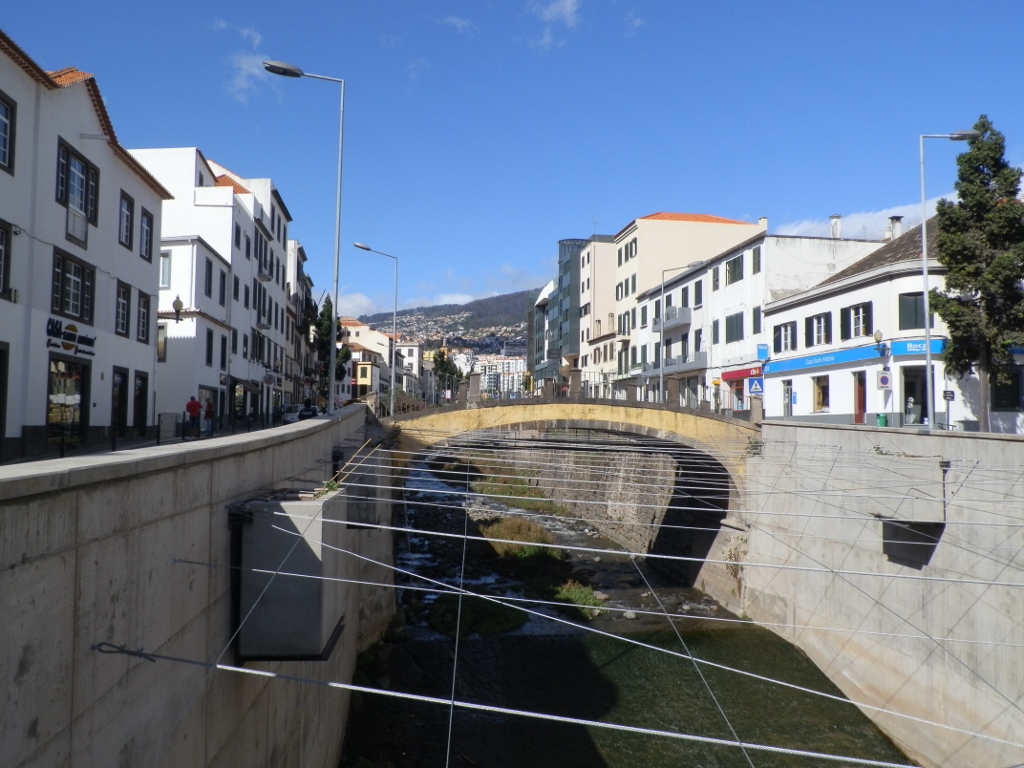 Bed of one of the rivers which in Funchal flow into the Atlantic Ocean
Bed of one of the rivers which in Funchal flow into the Atlantic Ocean
As I’ve mentioned earlier, because of the loss of my luggage when arriving here the day before, I took the advantage of the morning walk around Funchal to buy a few things which I thought were necessary in case my bag did not arrive at all. Although my first impressions about Funchal as I descended down the steep streets from the hotel to the centre and later when I walked around the centre were very positive, I felt as if the air humidity were quite high and that exhausted me and I wanted to rest a little, without going for coffee and/or pastries again. After all, I do have my limits. On the other hand, I also wanted to take advantage of the fine weather to make sure the newly bought t-shirts and underwear that I wanted to wash would dry. All in all, I decided to go back to the hotel. It was also important for me to check again if there was any news about my luggage, with a great hope that perhaps it had already arrived in my hotel.
Despite that fact that I did not have the guidebook with me, since it was also in the lost luggage, I actually found my way around quite well. So, I decided to catch a bus in a nearby street that would take me uphill in the direction of the hotel.
While walking from the bus stop to the hotel, I passed by a very small chapel. This is the Poor Souls Chapel (Capela das Almas Pobres). As it can be seen in the photo below, it was closed at the time I was passing by, plus I was also a little tired and did not even cross the street in order to peek inside (I will certainly remedy this the next time I go to Madeira). This chapel, the construction of which was ordered in 1781, is in fact very interesting. It is said that this is the smallest chapel in the world and it is dedicated to the poor souls in the purgatory, as allegedly its construction was ordered by somebody who had survived an attack in this particular place, so with the construction of the chapel and its dedication to the poor souls the person wanted to express his gratitude to the Creator.
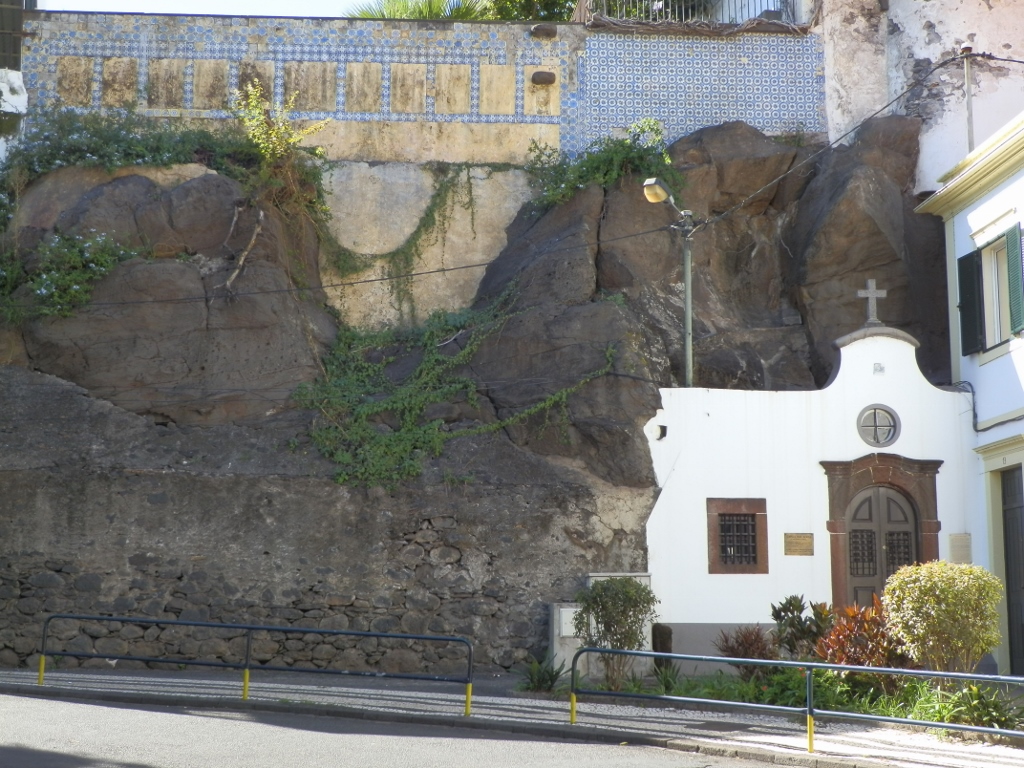 Poor Souls Chapel
Poor Souls Chapel
Then I got to the hotel, but there I faced a great disappointment and quite a stress. First, I was not welcomed by a pleasant surprise and my luggage did not wait for me at the reception. Moreover, when I called the airport it turned out they had absolutely no clue as to where my bag was and thus there was no information whatsoever! This upset me very much, but there was nothing I could do, so I just went up to my room and washed those things I bought in the morning leaving them out to dry. I sat for a short while on the terrace by the swimming pool that served as an exceptional viewpoint, but I was just far too nervous and could not settle in one place. So, after this short break in the room, I got down to the reception and went out once again in order to continue with the sightseeing.
I decided to go first to the museum that was close to the hotel. This was the Quinta das cruzes and it is one of the Funchal museums that come highly recommended. To start with, I was so frustrated and under stress because of the whole thing about my luggage that when I was buying the ticket I felt the need to tell that poor woman at the ticket-office all about my situation and in fact I was on the verge of tears. This was about the feeling of complete powerlessness and I find it to be a very unpleasant feeling. I did organise myself well and bought everything I needed, but this had nothing to do with the reality. I just wanted my things and I wanted the absence of the feeling of powerlessness. In other words, I wanted everything to feel normal. In an attempt to recreate this feeling of normalcy within myself, I started with the visit to the museum.
The Quinta das Cruzes Museum is one of the best museums on Madeira and it concretely deals with decorative arts, including different pieces of furniture, jewellery, pottery and sculptures from Portugal, Europe and other parts of the world from the period from the 15th century to the 19th century. In the place of the present-day museum João Gonçalves Zarco who had “discovered” Madeira had his last residence built in the second half of the 15th century. Over time this manor estate (quinta in Portuguese) was considerably changed and in 1946 it was bought by the state turning it into a museum that was opened in 1953.
In addition to the interior of the museum, the rest of the estate that surrounds the museum is also very interesting. Namely, there is a park with beautiful exhibits, including some stone royal coat-of-arms or window frames covered in ivy.
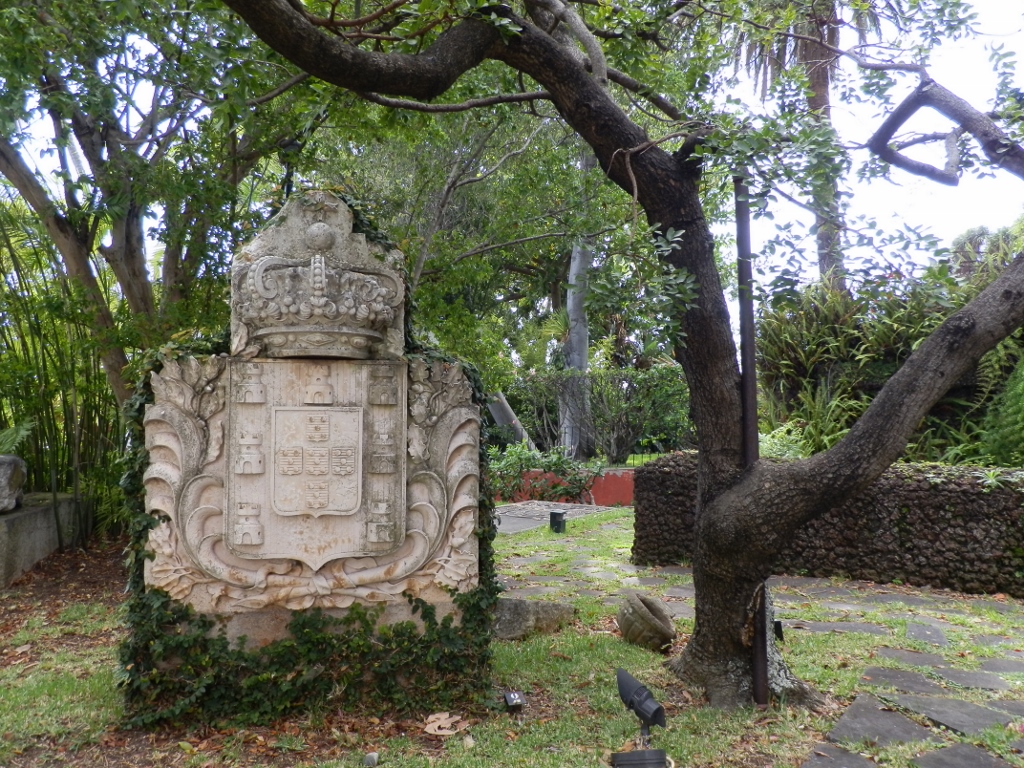 Quinta das Cruzes Museum’s park
Quinta das Cruzes Museum’s park
The window frames, and there are two of them within the park, stand out in particular, since they come from the 16th century and were done in the Manueline style or the Portuguese late Gothic style.
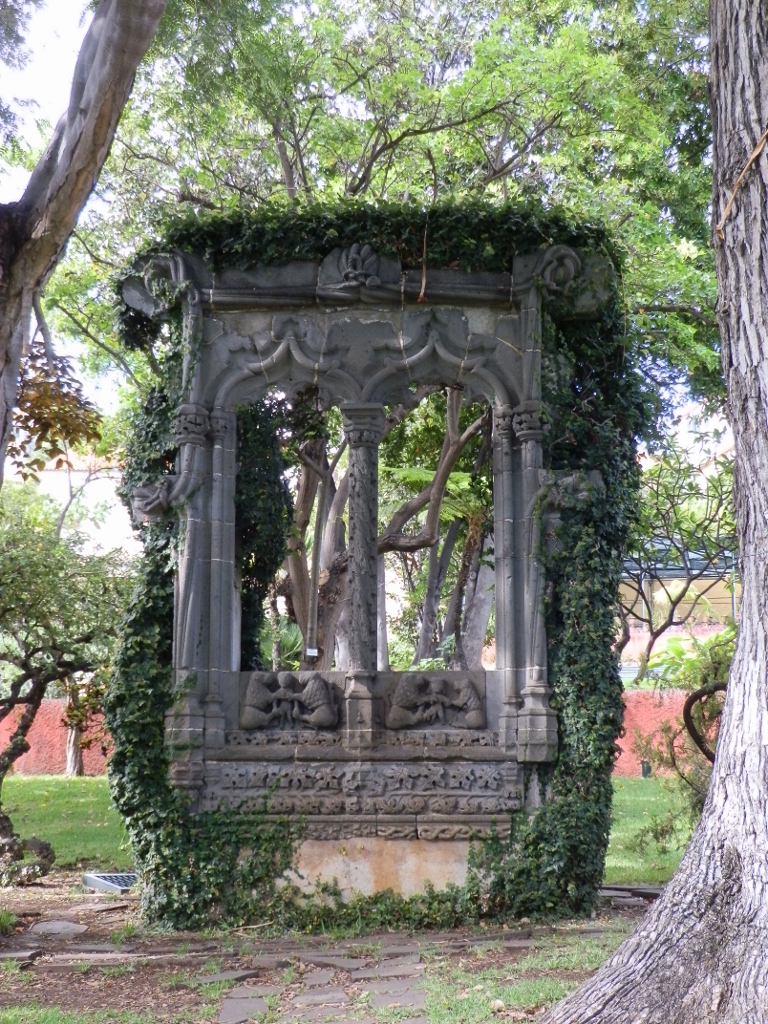 Basalt window frame done in the Manueline style
Basalt window frame done in the Manueline style
Coming to this museum and indeed to this park constituted a real remedy for my inner state of increased stress. Specifically, it was wonderfully quiet in the park and I could only hear some birds, which certainly had a soothing effect.
As a part of the park, there is also a smaller botanical garden or rather an orchidarium. At the time of the year when I was there, the orchids were mostly dormant, but there were some other interesting plants.
For instance, the Canary Islands dragon tree (Dracaena draco), a type of subtropical trees that is endemic on the Canary Islands, on Madeira and a few other places. The one seen in the photo below grows right next to the orchidarium.
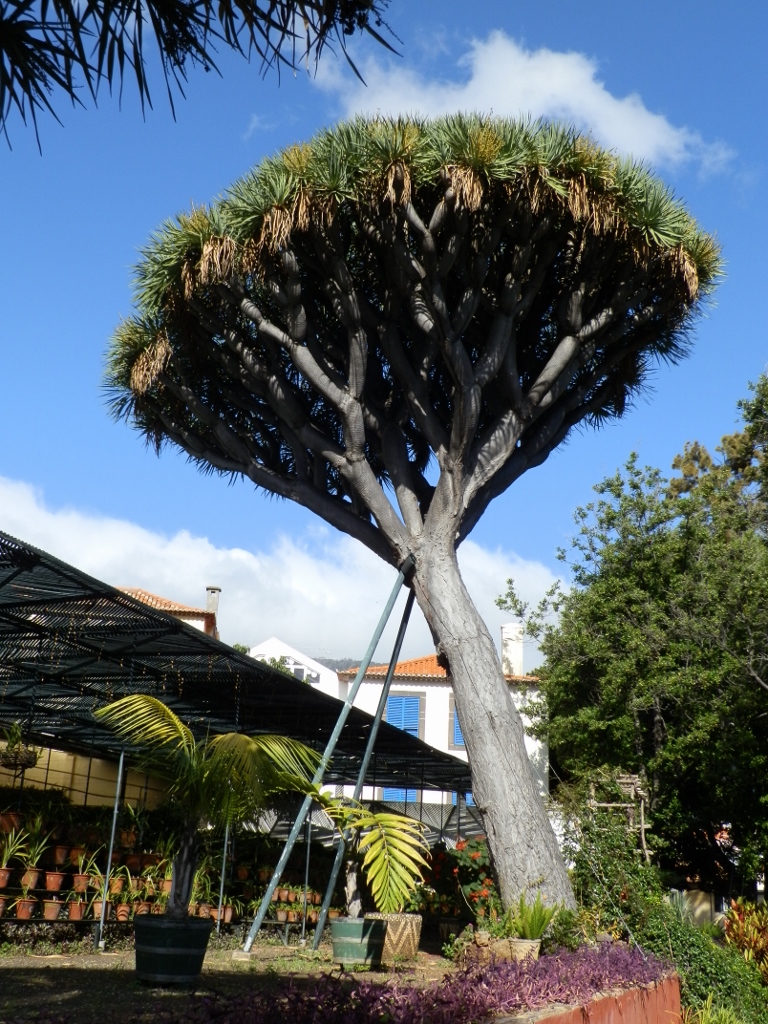 Canary Islands dragon tree; the orchidarium pots may be seen to the left
Canary Islands dragon tree; the orchidarium pots may be seen to the left
Needless to say, the bird of paradise flowers grew here in abundance, too.
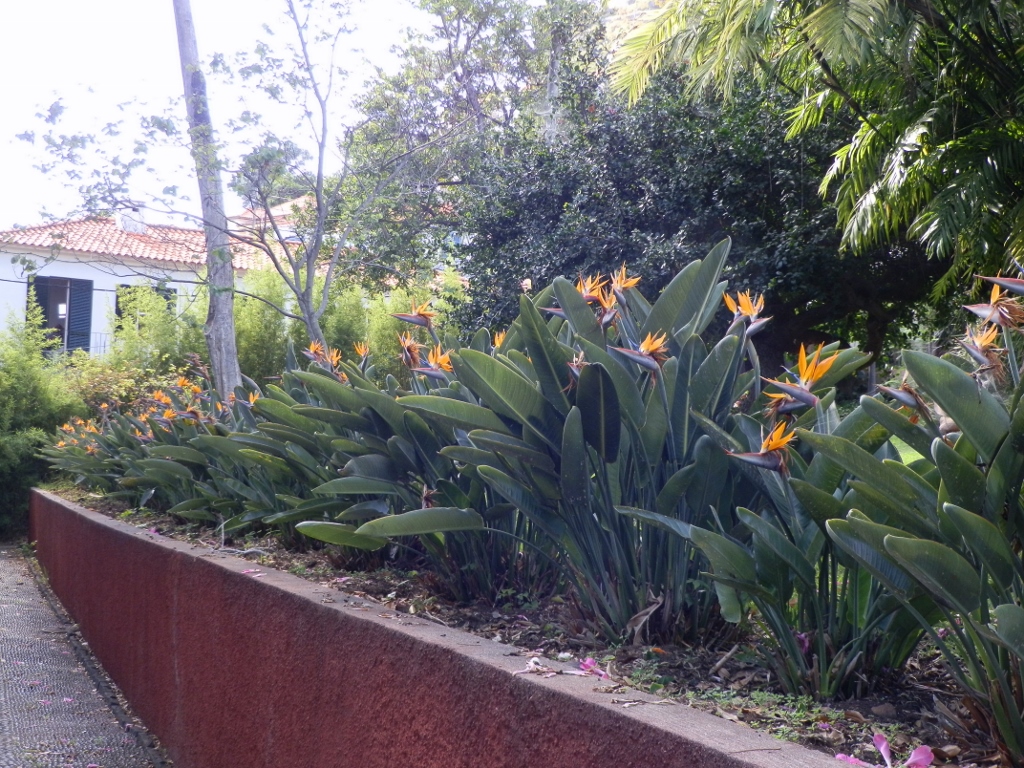 Bird of paradise plants
Bird of paradise plants
I find these flowers very inspirational for photo-taking. Although I have already posted some photos, here are some more as evidence to how much they inspire me.
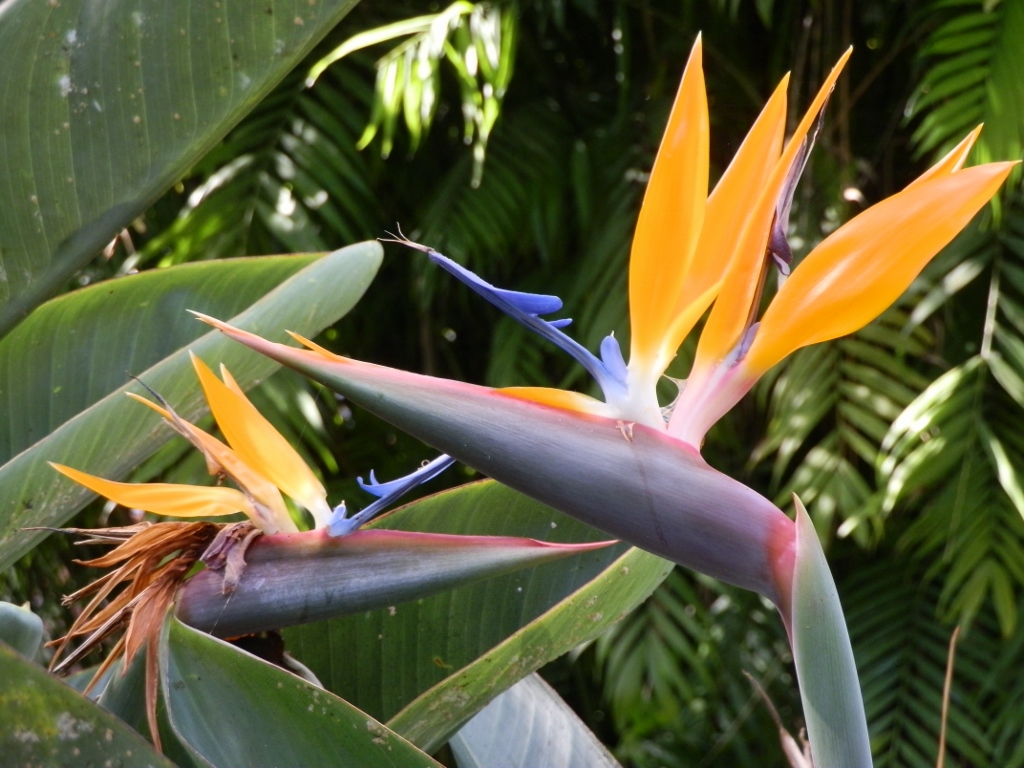 Bird of paradise flowers
Bird of paradise flowers
 Bird of paradise flower
Bird of paradise flower
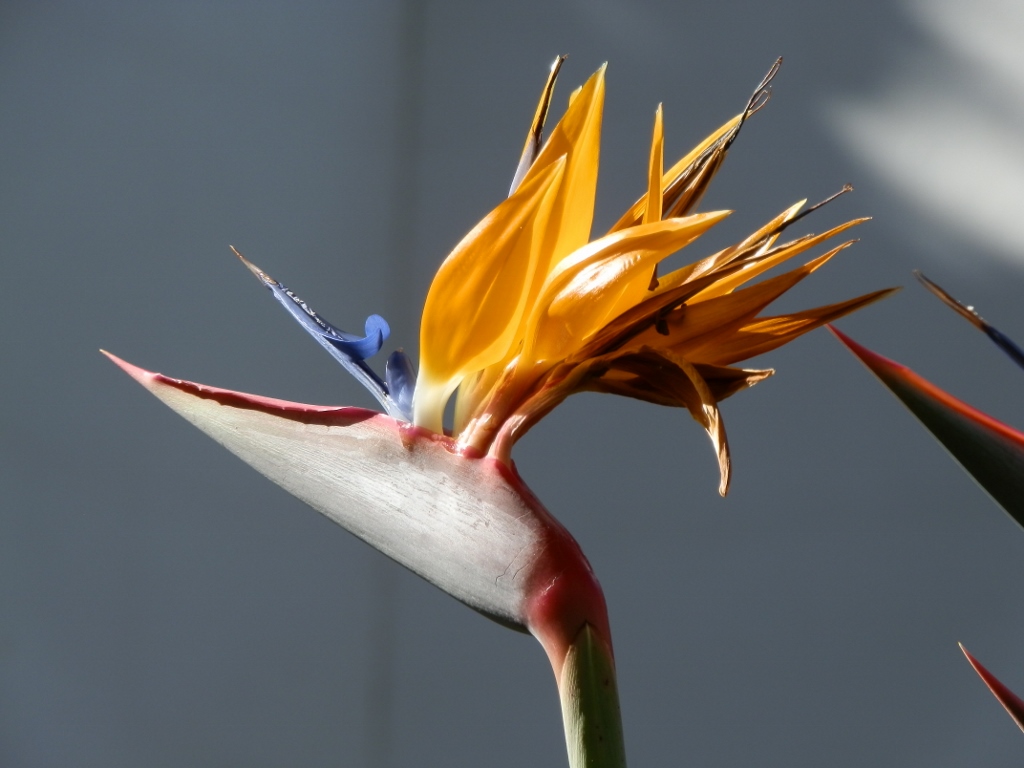 Bird of paradise flower
Bird of paradise flower
Still, in addition to the birds of paradise flowers, there was also one relatively lonely orchid.
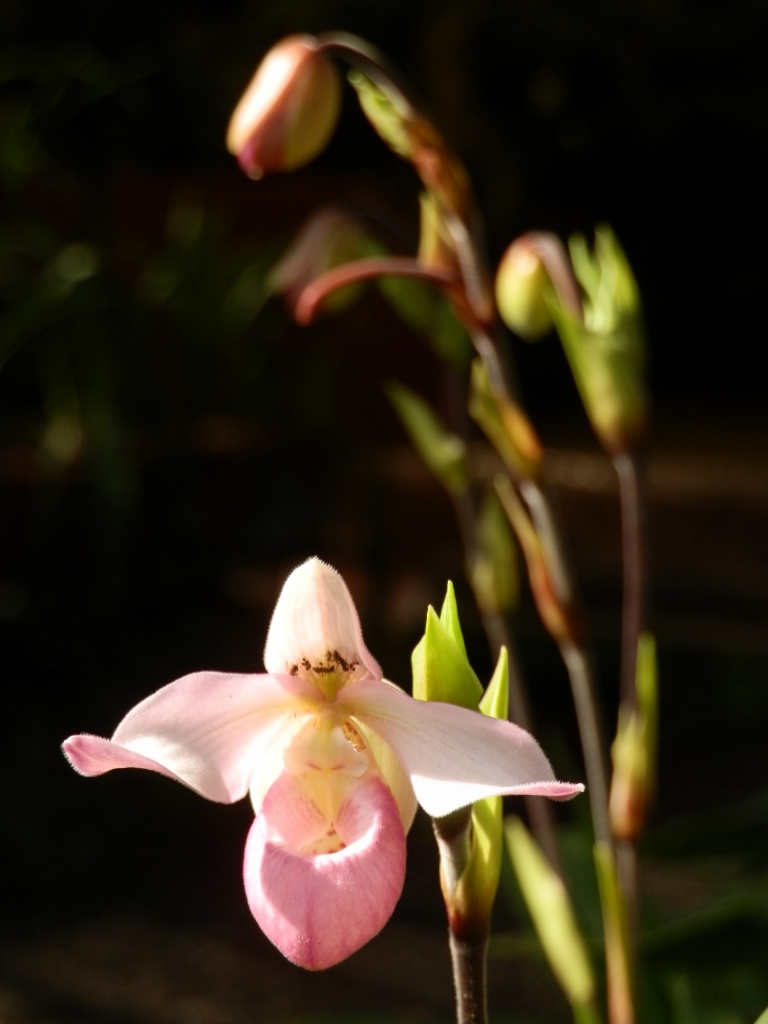 Orchid
Orchid
After this brief enjoyment in plants and flowers, I left the museum and continued to go down the street in the direction of the centre of Funchal.